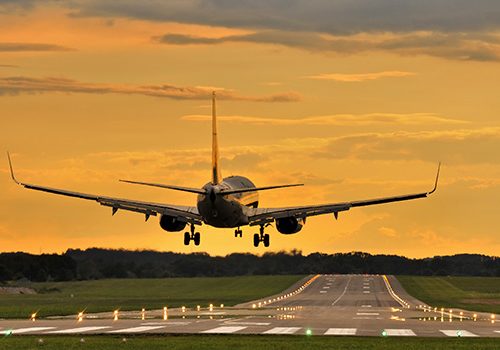Runway Lighting
atg Airports runway lighting systems include LED inset and LED elevated fixtures from the FX range in addition to tungsten halogen fittings from the ZA range. Click on the products below to see more information about specific models.

There are many different designs with regards to runway lighting systems, with the applications that are required being dependent on the category of the airfield, whether it be CATI, CATII, CATIII. The position at which the lighting fixtures are installed will also regulate whether inset type, or elevated products are used.
Runway edge lights are generally steady white lights that show the edge or the usable part of a runway. On instrument runways, the white lights will change to yellow when approaching the end of the runway length, turning red as the aircraft reaches the end of the runway.
There are several categories of runway edge lighting, high-intensity (HIRL), medium-intensity (MIRL) or low-intensity (LIRL) all of which are designed to meet different criterial of international standards.
Runway Centerline Lighting System (L-850A) – On precision runways, a runway centerline light system is installed, with white lights spaced at pre-determined intervals on the centerline of the runway. Towards the end of the runway the coding of the lights change to alternate red and then all red, thus indicating to pilots, the length of runway remaining.
Touchdown Zone (TDZ) (L-850B) Lighting must be provided on runways available for use in low visibility conditions so as to provide enhanced identification of the touchdown area. The method of provision is specified in ICAO Annex14 and the lighting must extend from the landing threshold for either 900 meters or to the midpoint of the runway, whichever is the least
Runway edge lights may be high or low intensity dependent upon the conditions for which the airport operates. The fixtures will generally be elevated types but inset fittings (IR850C or ZA483) will be used at runway and taxiway intersections and runway access points. Elevated fittings (IR862 or ZA163) generally provide a bi‑directional high intensity characteristic and an omni‑directional low intensity characteristic from a combined array.
Runway edge lights are usually white except on a precision approach runway without centreline lighting, yellow lights should be installed on the last 600m. Where a threshold is displaced, the lights between the beginning of the runway and the displaced threshold should show Red in the approach direction.
Threshold lights indicate the start of the usable part of the runway and dependent on the scale or category of the runway comprise two elements. Firstly a bar of inset lights at the start of the runway, and secondly two wing bars outboard of the runway edge. All threshold lights show green light into the approach.
The threshold is normally uni-directional inset luminaires, however where it is co-located with the runway end bar it may consist of bi-directional luminaires showing green into the approach and red to the end of the runway. The wing bar luminaires are uni‑directional elevated or inset luminaires depending on their location.
Runway end lights signify the end of the usable runway. They show red light in the direction of aircraft landing or taking off, and denote the extremity of the usable runway for landing, manoeuvring or take off purposes.
Runway end identifier lights (REIL) are a visual warning for pilots approaching the end of a runway. REIL runway lights are usually elevated, but can also be inset into the ground surface. Typical runway end lights are red in colour, to indicate danger.
Airport REIL lights work alongside other runway identifier lights to help prevent aircraft from overrunning on take-off or landing. Runway edge identifier lights provide another warning, as they turn from white to yellow towards the end of the runway.
REIL runway end identifier lights are a valuable source of information for pilots at a glance. Along with other runway identification lights, they improve safety and reduce the risk of an incident, especially when landing at night or in reduced visibility conditions.
Runway edge lights are light fixtures used to outline the edge of runways. They’re used at night or during periods of low visibility to guide pilots during approach and landing.
They may be high or low intensity depending upon the conditions for which the aerodrome is licensed. The luminaires will generally be elevated types but inset fittings will be used at runway and taxiway intersections.
Runway edge lights are generally white, but this is dependent where on the runway the light is located and whether a precision approach is being used.
On instrument runways, yellow lights replace the white for half the runway or the last 2000 feet, whichever is less, to provide a caution zone for landings.
For runways with a width of up to 50m, runway edge lights are installed at a nominal 60m ± 6m spacing
A runway end light is red in colour and indicates to the pilot when the runway finishes. These lights are usually elevated fixtures but can also be of the inset type.
Fill out the form below and a member of the atg team will respond within 48 hours.
"*" indicates required fields
Notifications